G.MAP special exhibition <Nam June Paik; Love is 10,000miles>
2023-12-01 ~ 2024-03-31
Gwangju Media Art Platform Gallery 1·2·3
062-613-6124
Free
Nam June Paik
160
This exhibition ‘Paik Nam June; Love is 10,000miles’ at G.MAP underscores the therapeutic power and value of art, featuring a display of Paik's video works, drawings, and archival materials. It includes the 〈Relaxing Optimism〉 video installation sculpture
본문
Paik Nam June (1932–2006) was a trailblazing artist who significantly expanded the horizons of contemporary art. He achieved this by seamlessly blending diverse concepts and mediums, such as the interplay of Eastern and Western philosophies, the integration of music with visual arts, and the innovative fusion of new scientific technologies with traditional culture. This exhibition provides an immersive journey into the life of Paik, a dedicated artist who spent his lifetime creating “art that never existed before,” consistently transcending established boundaries and challenging conventional norms.
The theme of this special exhibition, ‘Love is 10,000miles,’ is derived from the subtitle of one of Paik’s 〈Neon TV〉 series from 1990. It resonates with his macroscopic vision, which sought communication with the world and even the universe, free from the constraints of time and space. Unbound by the frame placed around the artist as “the pioneer of video art,” the exhibition highlights the person Paik was while surveying aspects of humanity in the age of technological media through the lens of human-machine-nature coexistence as foreseen and actualized by Paik.
The exhibition is largely divided into three sub-themes: “Green: Meditation,” “Red: Passion,” and “Blue: Hope”. These reference the colors and messages embodied by 〈Three Elements〉, one of Paik’s later works produced over a three-year period, from 1997 to 2000, to reflect on the spirit of avant-garde and post-video ideas
that he refused to let go of even toward the end of his life. Composed of non-linear laser beams, 〈Three Elements〉 comprises a circle, a square, and a triangle—which, in Korean culture,respectively symbolize heaven, earth, and humans—and the three primary colors of light: red, green, and blue. A masterpiece epitomizing the master’s open mind and experimental spirit,this work is a result of Paik’s persistent pursuit of transboundary communication through electronic media.
In this regard, "Green: Meditation" presents a world in which different concepts, such as East and West, science, technology, and traditional elements, come into contact with the medium, and "Red: Passion" remembers and reflects on the experimental spirit through Nam-Jun Paik's archives, including the Fluxus period. "Blue: Hope" discusses "digital humanism" based on Nam-Jun Paik's prediction of the 21st century as an era in which nature and mankind coexist through electronic media.
Through this special exhibition, I hope that visitors experience the healing and communication he wanted to realize while crossing the media and art, and face the future he has drawn, that is, the present, and eventually consider the world that an artist has dreamed of for all his life.
The theme of this special exhibition, ‘Love is 10,000miles,’ is derived from the subtitle of one of Paik’s 〈Neon TV〉 series from 1990. It resonates with his macroscopic vision, which sought communication with the world and even the universe, free from the constraints of time and space. Unbound by the frame placed around the artist as “the pioneer of video art,” the exhibition highlights the person Paik was while surveying aspects of humanity in the age of technological media through the lens of human-machine-nature coexistence as foreseen and actualized by Paik.
The exhibition is largely divided into three sub-themes: “Green: Meditation,” “Red: Passion,” and “Blue: Hope”. These reference the colors and messages embodied by 〈Three Elements〉, one of Paik’s later works produced over a three-year period, from 1997 to 2000, to reflect on the spirit of avant-garde and post-video ideas
that he refused to let go of even toward the end of his life. Composed of non-linear laser beams, 〈Three Elements〉 comprises a circle, a square, and a triangle—which, in Korean culture,respectively symbolize heaven, earth, and humans—and the three primary colors of light: red, green, and blue. A masterpiece epitomizing the master’s open mind and experimental spirit,this work is a result of Paik’s persistent pursuit of transboundary communication through electronic media.
In this regard, "Green: Meditation" presents a world in which different concepts, such as East and West, science, technology, and traditional elements, come into contact with the medium, and "Red: Passion" remembers and reflects on the experimental spirit through Nam-Jun Paik's archives, including the Fluxus period. "Blue: Hope" discusses "digital humanism" based on Nam-Jun Paik's prediction of the 21st century as an era in which nature and mankind coexist through electronic media.
Through this special exhibition, I hope that visitors experience the healing and communication he wanted to realize while crossing the media and art, and face the future he has drawn, that is, the present, and eventually consider the world that an artist has dreamed of for all his life.
About the Work
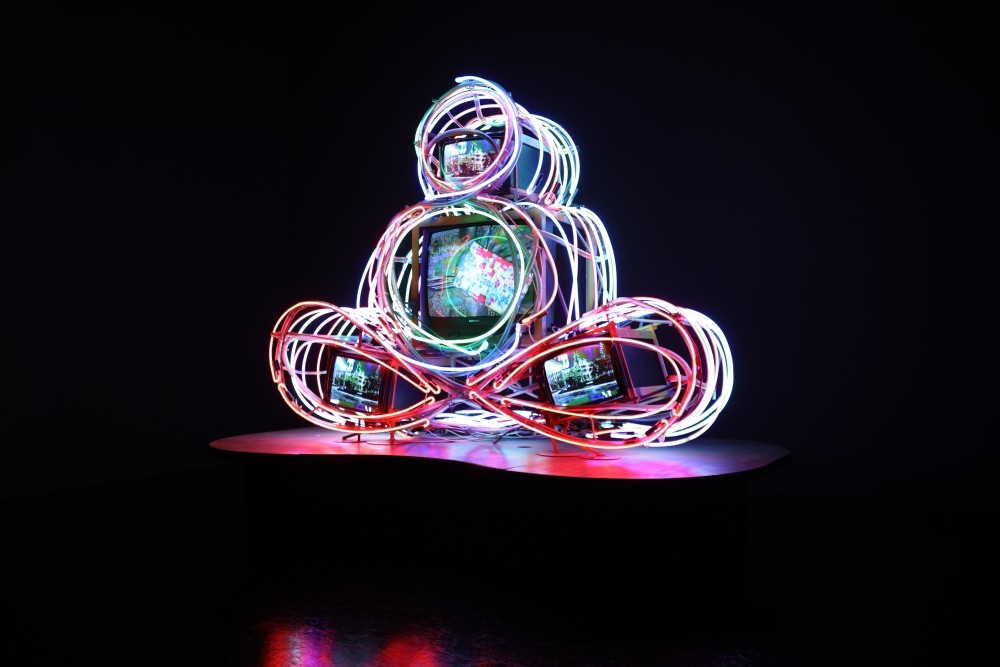
Name
Paik Nam JuneTitle
Blue BuddaYear
1992-1996Scale
Dimensions variableMaterial
Comprised of four televisions and neon lightsDescription of work
Comprised of four televisions and neon lights, the 〈Blue Buddha〉 sits in a lotus position, gazing at the viewer.
The Buddha figure comprised of byproducts of machine civilization seems to urge balanced thinking, advising against bias toward any one side of such concepts as machines and humans, spirituality and physicality, the East and West, and internal and external worlds, while the blue glow symbolic of mercy and peace gently embraces the onlooker.
The Buddha figure comprised of byproducts of machine civilization seems to urge balanced thinking, advising against bias toward any one side of such concepts as machines and humans, spirituality and physicality, the East and West, and internal and external worlds, while the blue glow symbolic of mercy and peace gently embraces the onlooker.
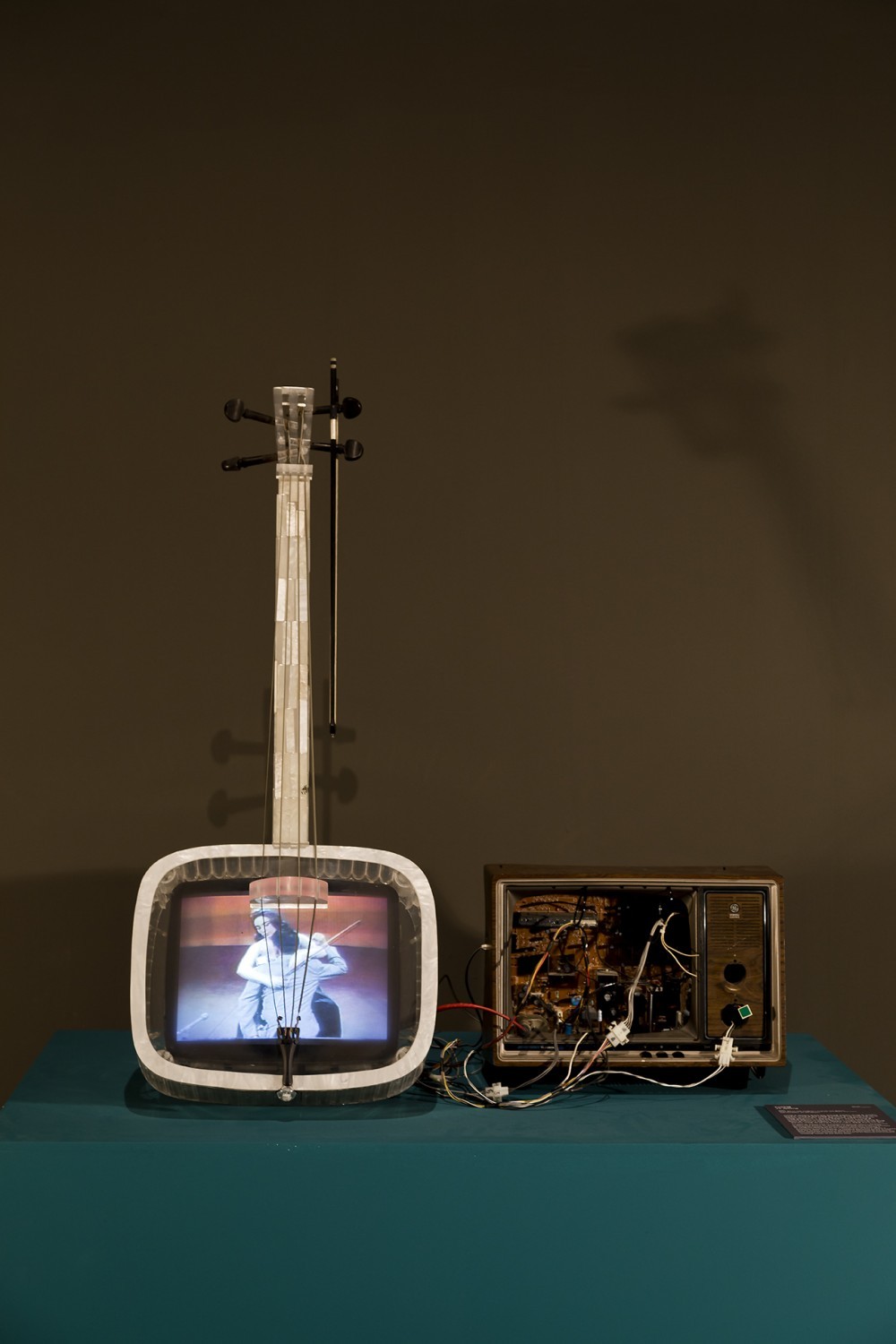
Name
Paik Nam JuneTitle
TV AjaengYear
1994Scale
Acrylic box, TV monitor, DVD playerMaterial
Video installation TV, Ajaeng,Description of work
‹TV Ajaeng› shows how to express Korean beauty or “Koreanness” in Nam June Paik's art. Through ‹TV Ajaeng›, Nam June Paik generalized Korean material and paid attention to its universality by using the ajaeng as an art object rather than limiting it to traditional instruments in a special area of Korea. When a performer plays ‹TV Ajaeng›, a colliding electronic sound is created and the screen in the TV is distorted or deformed by the sound. Nam June Paik wanted to show the combination of humans and technology by presenting the process of TV Ajaeng and humans ‘creating’ music at the same time.
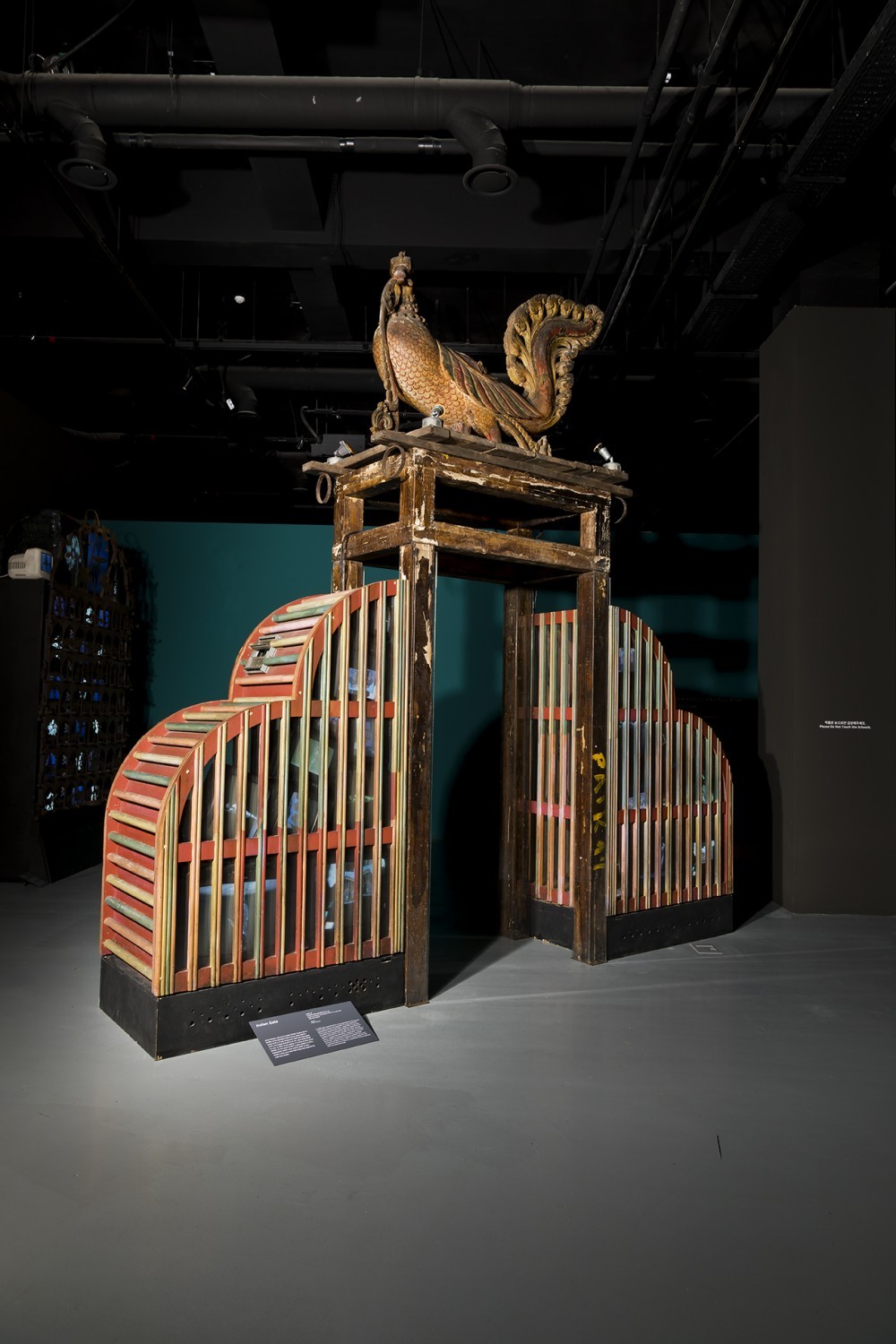
Name
Paik Nam JuneTitle
Indian GateYear
1996-1997Scale
Dimensions variableMaterial
Video installation with 21color televisions and woodDescription of work
In 1996, Nam June Paik lived in the United States and produced ‹Indian Gate› based on the perception of Indian racism that was prevalent in the United States. ‹Indian Gate› contains the meaning of communication and solidarity to eliminate racism in society by passing through this gate and further entering the door of the other's mind. The side of the door is decorated with a TV monitor that symbolizes modern times, and on the screen, images of Indians and East and West are played. On the door, a phoenix was installed to symbolize peace and harmony in Eastern cultures. Nam June Paik created the door to communication as a fusion by combining traditional elements with advanced technology.
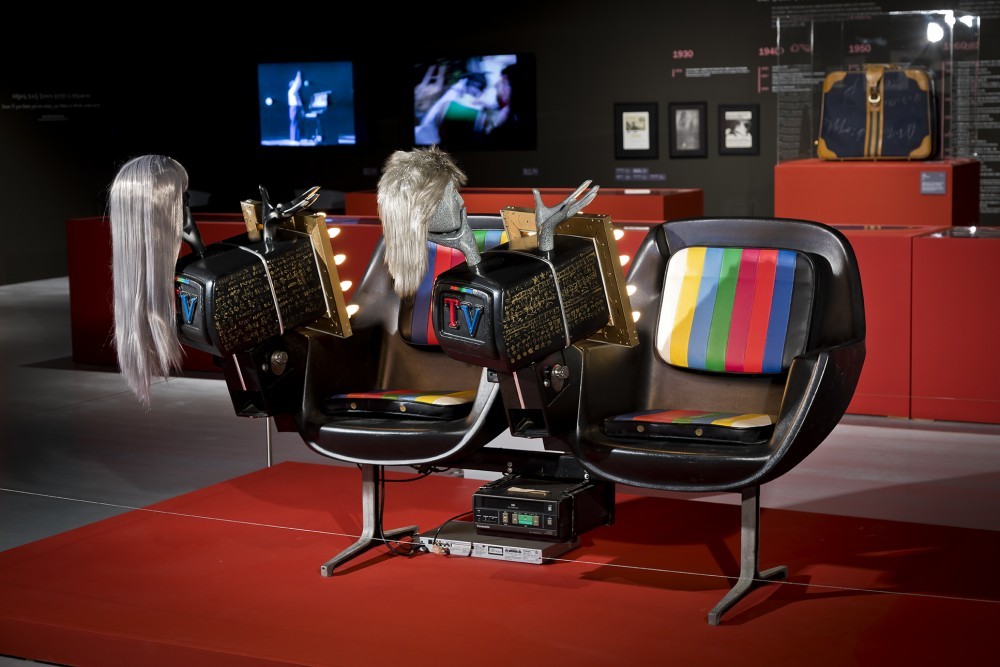
Name
Paik Nam JuneTitle
Drama is Not Theatre 1988Year
1988Scale
Dimensions variableMaterial
Mixed media video sculpture with 2 JVC monitors, VHS tape player and 30 minute Paik video program on VHS tapeDescription of work
‹Star Is Not Actor 1988› and ‹Drama Is Not Theatre 1988› are two works of the five-chair series, mixed-media sculptures using coin-filled TV benches placed throughout the US airport in the 1980s. Nam June Paik mentioned a particular field of art in the title of his series of five chairs. A star is not an actor, drama is not a play, literature is not a book, dance is not art. Distorted video clips are played on the screen on the monitor, Korean Hahoe masks or African masks are attached to the monitor, and hieroglyphics are engraved on the right. As such, Nam June Paik simultaneously conveys the multifaceted perspective inherent in contemporary media consumerism by combining totemic elements and media to illuminate the chaotic situation of the times.

Name
Paik Nam JuneTitle
Beuys VoxYear
1988Scale
Dimensions variableMaterial
Mixed mediaDescription of work
Beuys Vox is a work produced in honor of writer Joseph Beuys (1921−1986), who was the closest artistic colleague to Nam June Paik. Paik held a memorial service for Joseph Beuys after his death and went so far as to say that he was able to succeed because he met and made friendships with Beuys when he was unknown. As the title of the work implies, ‘Beuys’ Voice’, the work consists of 21 records that archive Beuy's various artistic voices. When Beuys and Paik did not know each other well, they collected and engraved memories of Beuys, who was a colleague who had a lot of influence on his life, including accidental photos taken together, collaborative photos, LP records recorded live performances, Beuys' drawings, and four screens with Beuys' images.

Name
Paik Nam JuneTitle
Video chandelier no.4Year
1990Scale
Dimensions variableMaterial
Video disc players, Chandelier, CandleDescription of work
A chandelier usually spreads beautiful light around it by placing several luminous candles and attaching shiny decorations such as crystals. A chandelier decorates the space splendidly, symbolizing wealth, achievement, and high social status. In ‹Video Chandelier No.4›, several TV monitors emit flashy images on a chandelier made of candles. Chandelier, which is composed of TV, is both a light that illuminates the space of everyday life and a medium that constantly conveys information. Nam June Paik shows that TV is now becoming an indispensable element in the environment surrounding us, along with the expanded imagination of the media space that transcends material limits through the Video Chandelier series
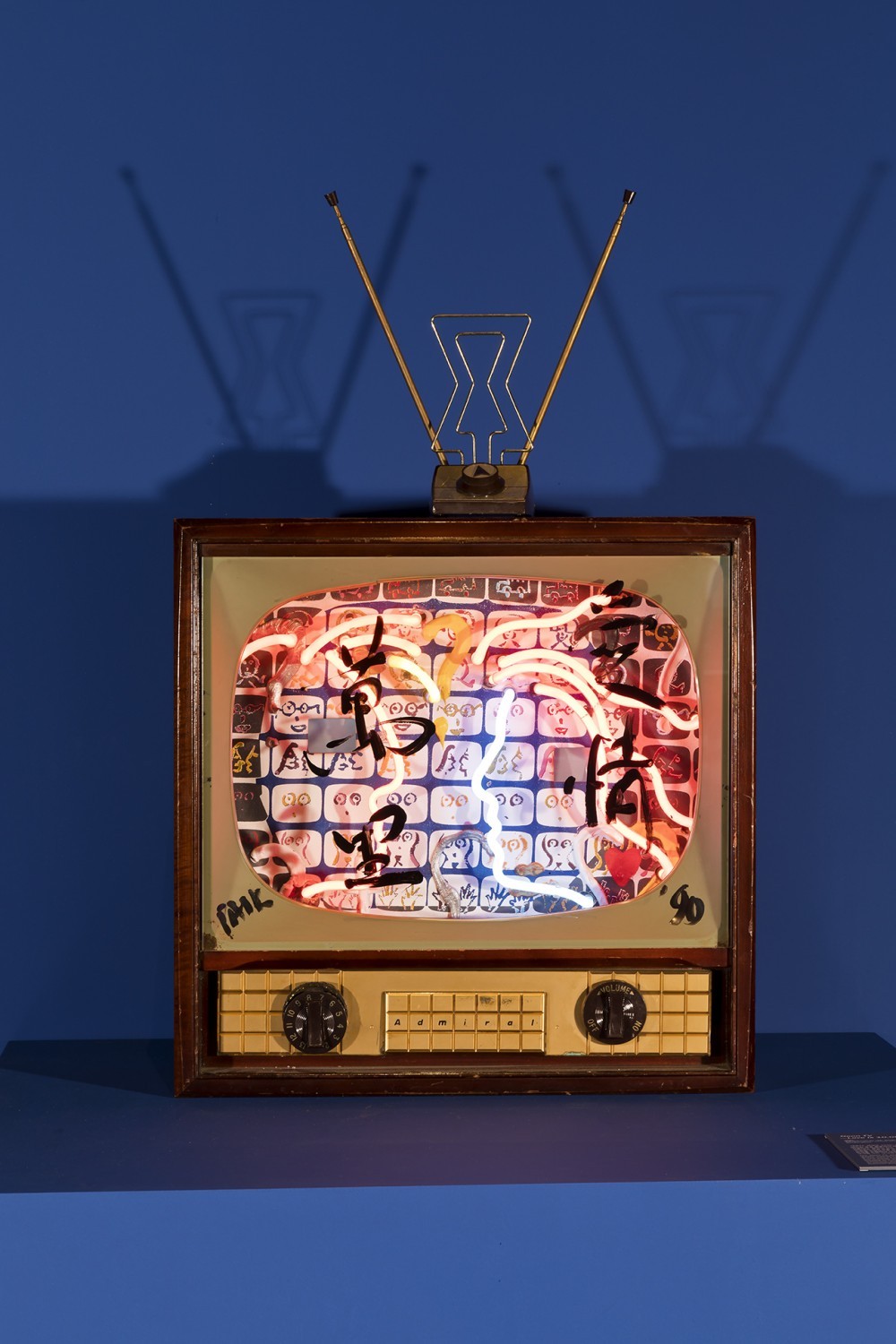
Name
Paik Nam JuneTitle
Neon TV-Love is 10,000 MilesYear
1990Scale
Dimensions variableMaterial
Mixed media (TV monitor, Neon, Watch man)Description of work
The ‹Neon TV› series is an abstract expression of Nam June Paik's artistic worldview by utilizing neon signs and paintings in vintage Braun tube TV in the 1950s to 60s. It symbolically expresses that a new world can be connected through television by depicting the universe with planets, neon glasses, and men and women looking at each other. The series ‹Neon TV› shows Nam June Paik's worldview, predicting that media will transcend physical distance or limitations to present new possibilities and become a medium between people and people, and the world and the world.
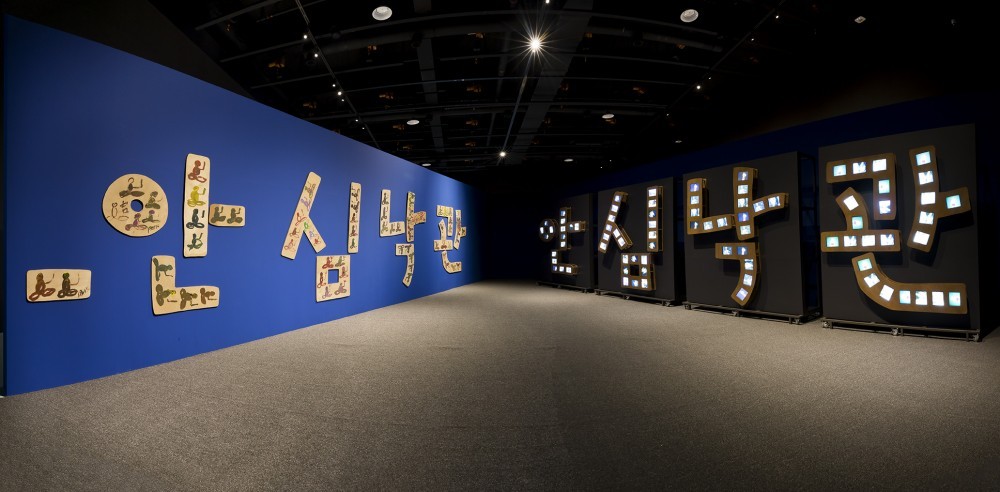
Name
Paik Nam JuneTitle
Relieved Mind and Optimistic VisionYear
1999Scale
Dimensions variableMaterial
Video installationDescription of work
Nam June Paik’s video installation work ‹Relaxing Optimism›, which was produced in the form of Korean alphabet letters, is the first work to be released by domestic and foreign cultural and artistic institutions through this exhibition. A blue Buddha is painted on the wooden panel displayed on the left. The work was created in 1966 when Paik was treated at a hospital in New York due to a stroke that paralyzed his left nerve. The doctor treated Paik, reassured him that he could continue his work, and encouraged him to optimistically think. He was deeply moved by the process of the doctor’s treatment and came to believe that ‹Relaxing Optimism› was the right treatment. For this purpose, Paik produced ‹Relaxing Optimism› and donated his work to Urideul Hospital, a hospital that specializes in spine treatment. 80 monitors show traditional Korean cultural costumes and at the same time Paik rehabilitating at a hospital. Even though he cannot stand up properly without the help of others, he does not show any signs of pessimism at all but rather embraces the people around him and shows an active attitude in rehabilitation and creative activities. Through this, Paik delivers a reassuring attitude of optimism to numerous patients in the same situation.

Name
Paik Nam JuneTitle
Robot PierrotYear
2000Scale
Dimensions variableMaterial
Mixed mediaDescription of work
Nam June Paik has continuously produced robot works starting with ‹Robot K-456›. Since then, Paik’s robot series has been highlighted in recreations and humorous forms since the 1990s. His robot works replace the human body with TV monitors and parts, radios, cameras, etc. The robot series, which proves the artist’s mention of humanizing technology, reveals its identity through the title of each work, and the various types of TVs and radios that make up the robot’s body express the humane personality. ‹Robot Pierrot›, which embodies a playful Pierrot in human society, consists of a TV frequency generator and a monitor, and vintage cameras and digital cameras are attached to the arms made of chains as if a Pierrot juggling. Paik presents the machine in the form of anthropomorphic sculpture and uses it not just as a technical tool but as an element that stimulates human imagination. Through the playful use of technology, it breaks down the boundaries between humans and technology. At the same time, it asks questions about how we should accept and make use of technology.
TOP
